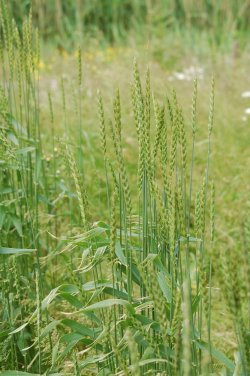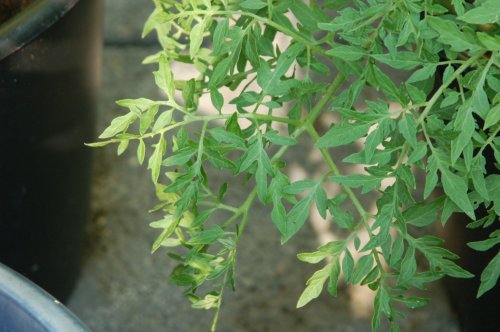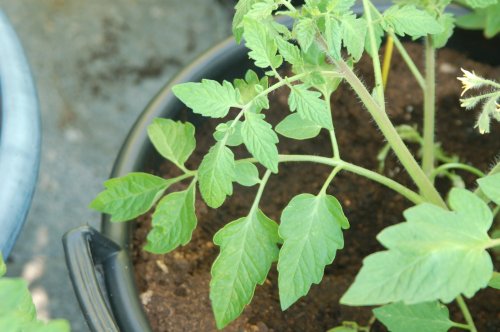Seed heads are forming on my spelt plants. It looks good so far…

Seed heads are forming on my spelt plants. It looks good so far…

Here is a picture of my ‘carrot leaf’ Silvery Fir Tree tomato.

For comparison, here is a picture of a normal tomato branch:

A post on this very important topic appeared on the Agricultural Biodiversity Weblog a few days ago while I was away. There are few more important issues impacting biodiversity than this one, and not just plants but animals too.
Almost too long ago to be remembered was the Irish Potato Famine. In this case it was a potato disease we now call late blight. The problem was the emergence of a new fungal disease combined with a food supply nearly completely dependent on a single crop. After the famine, the solution that emerged seemed too simple, a fungicide. Does this mean now potatoes can be sprayed with a chemical and we don’t have to worry about the disease anymore?
Not quite. The fungicides used to combat late blight are not only very toxic and expensive, but they can only be used to prevent and not cure late blight. That means when conditions are ripe for an outbreak, farmers must spray their crops every few days (more often if it rains) and they normally need to continue applying chemicals all the way until harvest.
Late blight is a quickly mutating disease, and every few years new chemicals need to be developed to control the disease, because the old ones stop working. These chemicals generally need to be made stronger and more toxic.
Until recently this disease reproduced asexually, which was very important because this limited it’s ability to mutate. In the last few years two distinct strains of the disease have met and begun sexual reproduction.
Now, about 150 years after the Irish Potato Famine, we are facing an unprecedented outbreak of similar fungal diseases in a wide variety of plants and animals. Blight, rust and smut diseases are now present in a wide variety of crops, and animals like frogs are being killed by fungal diseases in large numbers all over the world. The world’s food system is almost entirely dependent on two crops, corn and soy. These two crops are what feeds nearly all farm animals, and is the basis of nearly all processed foods. Corn in particular is becoming infected with fungal smut diseases.
The chemical companies aren’t worried, because for them it’s good business. They are confident they will continue to be able to manufacture more and newer chemicals as needed. Seed companies too can often develop resistant varieties, in the nick of time. The expense of these seeds and chemicals are often heavily subsided by governments, so the true cost is rarely passed on to consumers.
Any remaining costs that aren’t covered by subsidies are pushed back to farmers, who are rarely in a position to easily afford them. Farmers are usually powerless to approach the situation in a constructive way with biodiversity or practicing good crop rotation, because these options are commercially inviable or even illegal in some cases.
In recent years the responsibility for preserving our heritage varieties of plants has been transfered to commercial interests, who are reluctant to pay for preserving varieties vulnerable to these diseases.
Politicians are only too happy to accept short term solutions, because as long as they can finish their term in office without it becoming a serious problem, that’s all that matters to them.
We are quickly heading toward a very serious situation. Almost anyone who has been gardening for more than a few years will tell you these plant diseases have been getting much more of a problem. We really need to find ways to address the environmental causes for these diseases, and make politicians and others more aware of these problems so that action will be taken. If we aren’t there already, we will soon reach the point of no return.
Vancouveriste left a comment on my Bees and the Netherlands post and asked if I knew anything about Mason bees as home garden pollinators, and I must admit I don’t. Does anyone have any experience or knowledge of these? Are these too experiencing CCD, I wonder?
Several years ago when I started growing tomatoes in containers on my roof, it was a bit of trial and error to get a system that worked right and there wasn’t a lot of information about it on the Internet.
I’m still surprised at how often there are misunderstandings on the subject.
The year before last I offered some of my extra tomato plants to a neighbor who she said she would be pleased to take four of them. A few months later she told me they weren’t doing well, and asked me what could be the problem. She said the tomatoes were too small, and not getting ripe. After talking about it some more, she took me over to the plants and then the answer was clear. She had put the four plants, all in a row, in a window sill planter with about five liters of dirt.
Okay, first of all tomatoes (and most other vegetables) are different from flowers in that they need enough dirt to grow full sized, and need full sun, or the plants just won’t be healthy. The other thing to keep in mind is that heirloom tomatoes are different from commercial varieties, in that many commercial varieties are bred to be small plants, perhaps even be grown in a hanging basket or whatever.
Nearly all heirloom tomato plants are very large! They often grow over two meters (six feet), and can weigh well in excess of 45kg (100+ pounds). They will also need some support, usually in the form of a bamboo or plastic stake. They will need enough dirt to hold the stake and the container will have to hold a plant this big and still be stable. Keep this in mind when you are thinking about a good container to buy.
I find the most important factor is volume of dirt. I use containers that hold 30 liters (7.3 US Gallons), and I find this is both the minimum but also an amount that usually works okay. More is obviously better, if possible.
For dirt I usually use a mix of homemade compost and peat moss or similar potting soil. Keep in mind most potting soil contains chemical fertilizers, which you don’t want if you are gardening organically and can affect the way your tomatoes grow, and you don’t need any fertilizer if you are using compost. I prefer using plain peat moss instead of potting soil, which is usually cheaper anyway. If you have it, 100% compost is the best, otherwise a mixture of at least 30% compost is probably good enough. Tomatoes don’t like to share their root space with other plants, so put each plant in its own container.
One of the most common pitfalls with tomatoes is over-fertilizing, which results in a bushy green plant with few tomatoes and well as other problems. I usually don’t add any fertilizer, and if you use at least 50% compost in the soil mix it is certainly not necessary. If you must, fertilize with fish emulsion or similar only once or twice, starting in August.
One of the biggest challenges with growing tomatoes in containers is keeping them watered. In the perfect world, tomatoes like to be watered in the evening then dry out during the following day. This wet/dry cycle is important for healthy plants. If the plants are too wet, the tomatoes will crack. If they are too dry (or you don’t have enough dirt) you will get Blossom End Rot (BER). With BER the ends of the tomatoes turn brown and rot. The more dirt you use in your container, the easier it will be to regulate the water.
I use a water timer and a drip water system. I begin by watering only in the evening, but during the hottest part of the summer I water twice per day. During periods of heavy rain, I turn the water off.
The plants will need some support, either in the form of a cage or a stake. I find the easiest is a stake, in which case it’s important not to tie the plant too tightly, because the plant will grow.
What can go wrong?
The most common problem is BER. This problem is caused because something is keeping the plant from absorbing the nutrients it needs. Some people suggest adding calcium to the soil as a way to prevent it, but I find a soil deficiency is rarely the true cause. Usually the problem is too small of a container or not enough water. It can also be caused because when the plant was young you tied it to its stake with a piece of wire that was too tight, and it grew to the point the plant was pinched off with it. Sometimes it can take a little detective work to find the cause of this problem.
The next common problem is splitting, which is caused by irregular or over watering. Sometimes you are just cursed by rain, and there isn’t much to be done about it. The best thing is to try to get as close to the wet/dry cycle I describe above.
Many diseases affect tomato plants, some are more serious than others. It’s very unlikely you will go through a season without encountering something. The best way to address most problems is with hygiene. If moldy or brown leaves appear, remove them. Try to keep plants separated with air space between them as much as possible. Don’t put any diseased plant material in your compost!
One of the most catastrophic tomato diseases is blight, a disease shared with potato plants and one that is becoming more common all over the world. This causes large black or grey blemishes to form on the plants and fruit, and the plants normally die within several days. There is nothing you can do once your plants become infected. Infection can usually be prevented by growing the plants in a greenhouse, if this is an option for you. The theory is that a blight infection can only take place if the plant is wet, so if you protect them from rain and are careful not to get the plants wet when you water them, you can prevent the infection in the first place. This is a highly contagious disease, and the spores can survive several years. It is best to destroy infected plants as quickly as possible.
‘Wilt’ diseases are sometimes also encountered. In this case the leaves of the plant will wilt, and the growth of the plant will be severely stunted. Since the wilt diseases are soil borne, you are not likely to have a problem with it spreading to other plants if all of your plants are in their own containers. Infected plants will normally produce some tomatoes. If you have problems with this disease, there are resistant varieties of tomatoes available, unfortunately these varieties don’t usually include heirlooms.